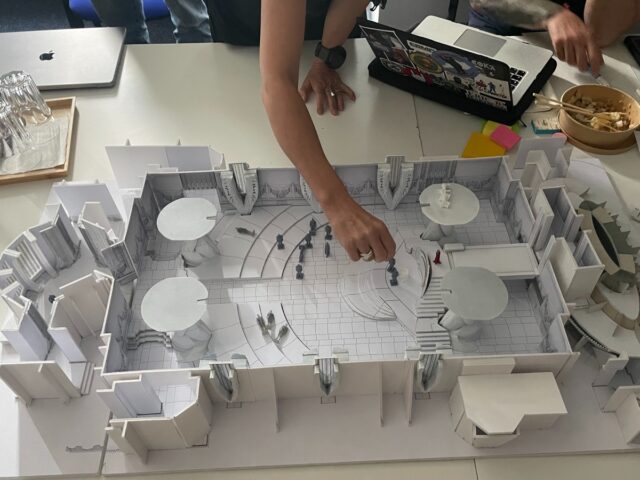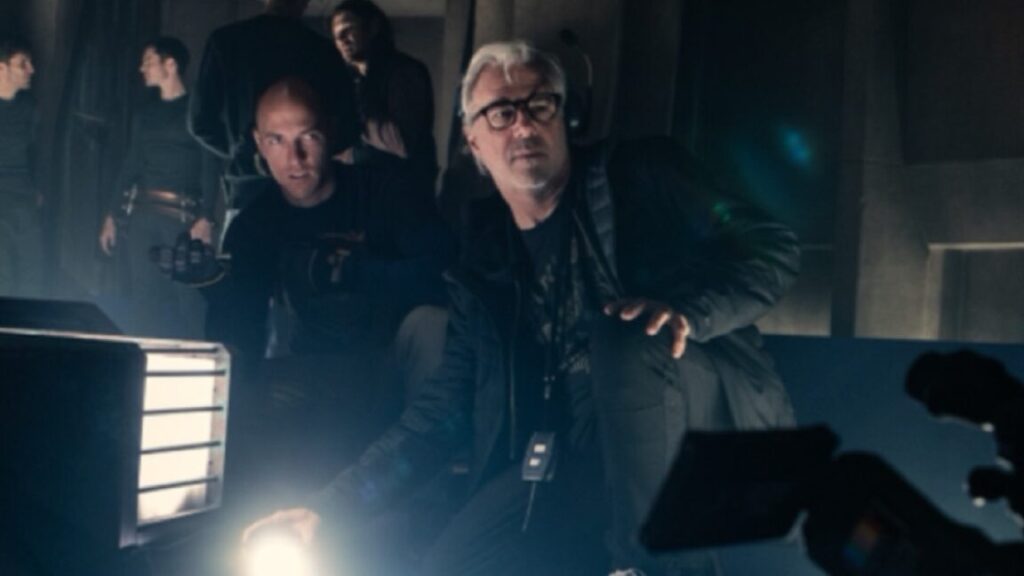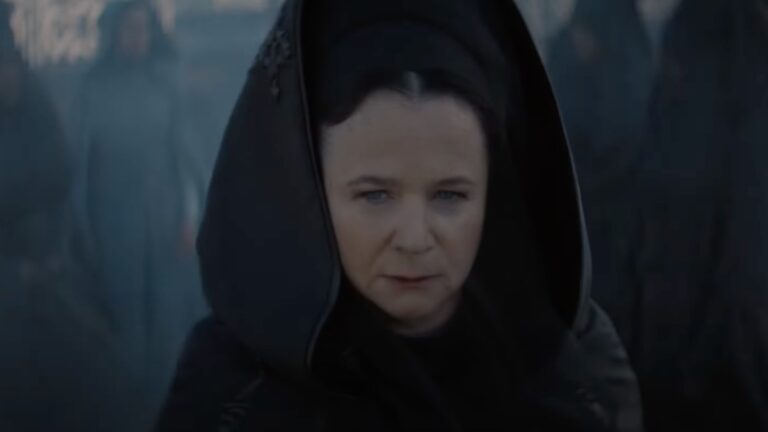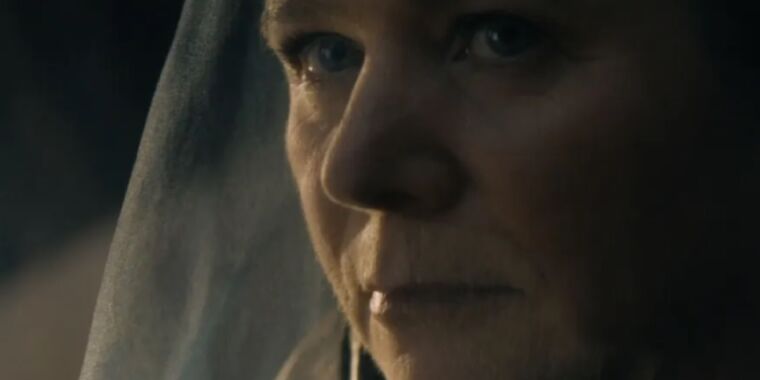How the worlds of Dune: Prophecy got their distinctive looks
a peek behind the curtain
Ars chats with Dune: Prophecy lead cinematographer Pierre Gill about color palettes, lighting, and other challenges.
Credit: Attila Szvacsek/HBO
Director Denis Villeneuve’s stunning two-part film adaptation of Frank Herbert’s Dune has received many well-deserved accolades—with Dune: Part 2 being crowned Ars Technica’s top movie of 2024. The films also spawned a lavish HBO spinoff TV series, Dune: Prophecy, just renewed for a second season right before a momentous season finale.
(Some spoilers below for S1 of Dune: Prophecy, but no major plot reveals.)
Dune: Prophecy is a prequel series inspired by the novel Sisterhood of Dune, written by Brian Herbert and Kevin J. Anderson, exploring the origins of the Bene Gesserit. It’s set 10,000 years before the ascension of Paul Atreides and follows two Harkonnen sisters as they combat forces that threaten the future of humankind, establishing the fabled sect that will become the Bene Gesserit in the process.
Emily Watson stars as Mother Superior Valya Harkonnen, who leads the Sisterhood and has a close ally in her sister, Reverend Mother Tula Harkonnen. They have built up a network of Sisters serving the rulers of various worlds as “Truthsayers,” including Princess Ynez (Sarah-Sofie Boussnina), heir to the throne of her father, Imperium Emperor Javicco Corrine (Mark Strong).
Valya’s master plan to crown a Sister as head of the Imperium hits a snag, however, with the arrival of a mysterious soldier named Desmond Hart (Travis Fimmel), who claimed he survived being swallowed by a sandworm while fighting on Arrakis. Hart has a mysterious ability to literally burn people to death from the inside out with his mind, and he so impresses the Emperor that Hart replaces Valya as key advisor. So begins several episodes of political intrigue as secrets from the past begin to come out, culminating with an action-packed finale that bade farewell to a couple of key characters.
All of this takes place against a stunning visual backdrop that is reminiscent of Villeneuve’s two films but also sets the series apart, as befits a prequel. One of the people responsible for that is lead cinematographer Pierre Gill, who created distinctive looks and color palettes for the various worlds, planets, and environments, as well as tackling the lighting challenges posed by the massive built sets. Ars caught up with Gill to learn more.
Ars Technica: You also did some work on the film Dune: Part 1. How was it different working on a TV series set in the same sweeping fictional world?
Pierre Gill: It’s a different game, a different schedule, and it’s also a very different approach because the scenes are different. There’s not so many subplots. But it’s still the same scope. We had as many sets and studios and everything. So it’s a big challenge to be able to keep the style, make it look good, light the actors. It’s part of the reality of the [director of photography’s] decision-making. You have ideas in your head of what you want to do, you have a dream, but it has to be feasible, realistic. So then you make compromises and figure out the best way to keep that style. There’s also multiple directors, there’s a showrunner. So the decision-making is less centralized.
Ars Technica: How did you go about setting the series apart from Villeneuve’s films, especially since it’s a prequel?
Pierre Gill: It’s set 10,000 years before, so it could have been extremely different. But it’s not a good idea to do that. First, the audience wants to see Dune because they love Denis Villeneuve’s movie. Second, it’s a complex story and it’s better not to get lost into something. It was not a good idea to do that in our mind. So we stayed not far from the movie so the audience can just sit down and follow the story points. and at the moment, Of course, some people always complain, but most are just happy to follow the story. So I think we made the right choice.
Ars Technica: Despite the epic scope of the series, you were able to shoot as much as 75 percent of the footage in-camera. That’s quite a feat.
Pierre Gill: There’s a lot of VFX of course, but because most of the sets were so high, so big, the camera was filming people or the throne room—which is gigantic—it’s almost always in camera. For the big wide shots, there’s a set extension that is painted. So these huge sets, the Sisterhood, the library and everything, when you see all these girls wandering around in that complex of Wallach IX, that compound is pretty much on camera.
A lot of VFX is making these gorgeous shots of the world, spaceships coming down, seeing something outside the window sometimes, and then the exterior of Wallach IX, which is two big towers and a rock facade. Of course there’s the little lizard, the thinking machine, that was VFX. But otherwise it was very, very in-camera, which makes your life easier in editing and shooting—although it doesn’t make my life easier with the lighting, which would be much easier with blue screen.
Ars Technica: Tell us about the massive chandeliers you built to introduce particle light, adding extra character to the interiors.
Pierre Gill: The sets were quite monochromatic. You have Salusa Secundus, the emperor world, which is a very sandy color, very beige,. And then you have Wallach IX, which is very gray. We decided to light one of the worlds in a cold way, the other world in warmer tones. I was trying as much as I could to put very harsh sunlight into the Salusa Secondus world.
Again, the sets were very big. So I asked the production designer Tom Meyer to build me some practical lighting somewhere. There was not much in the set for me to use for night, which is a bit of a problem because he kept the mood of Dune. On a film you have three to four hours to light a scene. I was not able to do that. I needed to have practical light that is actually lighting something. So for example, in the throne room, he wanted to have glass balls. There’s three glass balls, they’re gorgeous.
I told Thomas, “But these glass balls, the problem for me is the light behind my head is going to blow away. I would love this to light the wall.” So I got my practical team, a bunch of guys who are just in charge of LEDs on set. We found an LED source that goes inside; you can dim it down and up. But behind the balls, we added another pack of LED lights that are hidden. So you have the light source and just behind it you have this extra lighting. From the camera you never see it but it was lighting the wall. And then I got them to build a very long teardrop. I again got them to build multiple layers of LEDs that were on a board that was a certain power, certain color. I was able to make them cold or warm and to change them a little bit and use them as a source. It became part of the visual style.
Ars Technica. I appreciated that Dune: Prophecy seems to buck the trend toward very, very dark night scenes that end up being nearly unwatchable for people at home.
Pierre Gill: I don’t really like when it’s pitch black and dark. I don’t understand. I don’t think it gives anything. For me, night is more figuring out silhouettes. Let’s try to feel the character, shape your character on the wall, and when you get in a close-up you get a light in his eyes or something. I like to define a room and on these big sets to do moonlight would make no sense. The throne room is gigantic, but at the end it’s just an empty place. So you’re lighting what? Just the floor. It’s not very interesting. So what I’ve done for the night in the throne room, I asked VFX, what’s the concept of the exterior? It was all work in progress. We had some artwork concept work, but the lighting, nobody really knew.
So I said, okay, so we know there’s lights, so I’m going to put orange lights from below. I’m not lighting actors, I’m not lighting anything. But when you look at windows, you can feel that the light is coming from the bottom and it creates a few shadows. When you see outside now, they put all these lights in the palace, like you would light a nice, beautiful, gorgeous big house. You light everything from under.
Ars Technica: What were some particularly challenging scenes in terms of the cinematography?
Pierre Gill: The prison was a huge challenge. It was built on a set on location in downtown Budapest, and it’s a circular room. It’s where they put Desmond and suspended him in a jail cell. There was a floor and I had one foot to light. So that was complicated. Another challenge was the exterior of the Sisterhood: a big circular room outside. It was also a location and we could not access behind with cranes, so I could not control anything, and it was very dangerous. I could not light from the ceiling from the top of this coliseum. We built a gigantic tarp on top of it. So I was closing and opening and diffusing the sun. That was very Hollywood-esque.
Ars Technica: Was there a particular scene you were especially pleased with how it turned out?
Pierre Gill: In the first episode, there’s a scene with the young sisters chanting around a gorgeous golden bowl. The director, Anna Foerster, she wanted to see the waves of the singing and all these frequencies. I was like, “Well, that’s a lighting gag. You don’t see any wave if you cannot light in reflection.” I knew I wouldn’t have time to do something so technical. Since she wanted to “do a pull-up” for the scene: starting loose up on the bowl and then moving up and out. Technically it’s complicated.
So I had a big rig that I created around the camera with soft lighting that could reflect. And I asked our department, when they built that bowl, “Could you build with a light inside, like a waterproof light, an LED? I’ll put it on my board and maybe it’s going to work. I’m not sure if it’s going to really light the water properly.” I was ready with a plan B, but they brought the bowl, they started the frequency thing, and it was gorgeous. So I didn’t have to use my plan B lighting. That was very, very nice.

Models helped with the staging and lighting of different scenes. Credit: Pierre Gill/HBO
Ars Technica: The show has been renewed for a second season and one assumes you’ll be involved. What will be different for you going into S2?
Pierre Gill: I’m very proud because I’m part of building that, a part of the creative team. I really hope I can do it. I hope my schedule will allow it. I want to be part of this for sure, because S1 was a lot of engineering, meaning it’s so big, you have to figure out stuff all the time. Now it’s done, it’s built and we know what we like. We know what we don’t like. We know what works. So S2 for me, will be a lot of fun, much more creative, meaning I’m going to be able to do much more interesting lighting. I’m going to go deeper into the thing because I know how this beast is working now.
All episodes of Dune: Prophecy‘s first season are now available for streaming on Max.
Jennifer is a senior reporter at Ars Technica with a particular focus on where science meets culture, covering everything from physics and related interdisciplinary topics to her favorite films and TV series. Jennifer lives in Baltimore with her spouse, physicist Sean M. Carroll, and their two cats, Ariel and Caliban.
How the worlds of Dune: Prophecy got their distinctive looks Read More »



